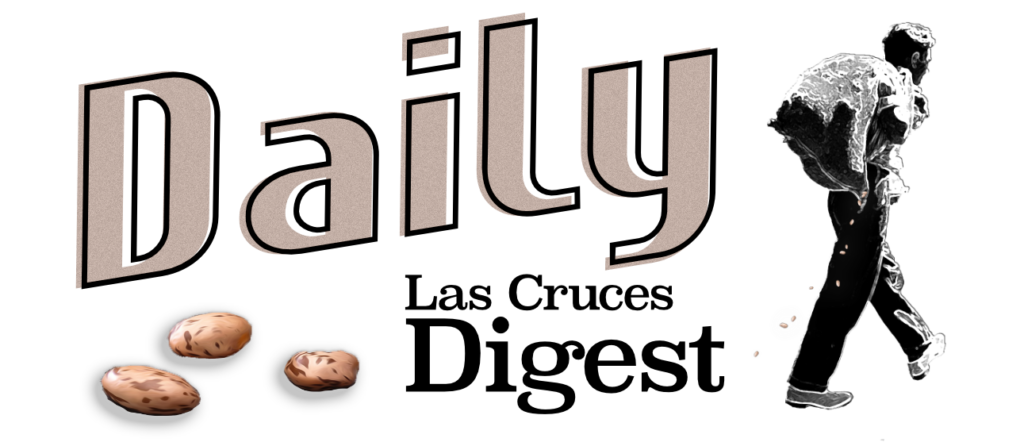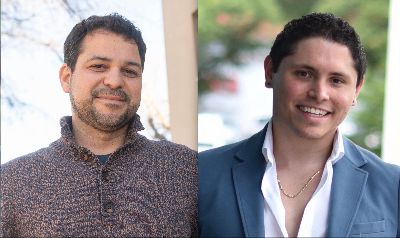After receiving his astronomy master’s, Manny Canas launched a full-time tech career with Booz Allen Hamilton as a software engineer with mentorship from astronomy professor Wladimir Lyra. (photos by Josh Bachman (left) and Justin Irick)
Source: NMSU News Release
July 24, 2024
WRITER: Xavier Dominguez, (575) 646-1614, xavierd2@nmsu.edu
NMSU alum’s astronomy degree takes him beyond the stars
Manny Canas earned a bachelor’s degree in astrophysics before choosing New Mexico State University in 2019 to pursue a master’s degree. Guided by NMSU astronomy associate professor Wladimir Lyra, Canas collaborated on Lyra’s 2022 NASA Emerging Worlds grant before earning his master’s in 2023.
“Manny absorbed everything like a sponge,” Lyra said. “It was a mentor-apprentice experience.”
After receiving his master’s, Canas launched a full-time tech career with Booz Allen Hamilton as a software engineer. He builds both the user interface and the server-side interactions of the software. The company has contracts with many government agencies from the IRS to NASA.
“My main focus is software development,” Canas said. “But I’d love to branch off sometime and go full circle and come back to astronomy. Picking up a contract with NASA would be phenomenal.”

Canas is originally from Colombia but grew up in South Carolina. Both his parents have college degrees. After earning a bachelor’s degree in astrophysics, Canas joined Lyra’s first cohort of graduate students at NMSU.
Canas collaborated with Lyra on his NASA-Emerging Worlds grant to research and implement new ideas about planet formation to explain objects in the so-called Kuiper Belt, the region of the solar system beyond Neptune, where Pluto lies. The idea was to explain the origin of Pluto and other Kuiper belt objects. The professor and graduate student worked on two publications together.
“The first one was a major update on the theory of planetary growth by accretion of small solids, which goes by the name of “pebble accretion,” Lyra said. “The second paper applied this update to develop a theory to calculate the mass and densities of objects in the Kuiper Belt and to explain the composition of those objects.” Link to first paper and link to second paper.
“The research was really exciting,” Canas said. “Previously, all the pebble accretion models that were run have been on a single type of pebble. But we did a “polydisperse” pebble accretion model, meaning you can have pebbles of different sizes and different densities and see how that affects the accretion rates onto planetesimals. To use our model to explain this density trend discovered in the Kuiper Belt was pretty astounding.”
From research and implementation of theories about planet formation to finding a career in technology, Canas credits his success to the Department of Astronomy and the hands-on research opportunities with Lyra that equipped him with skills which can apply to many fields.
“Having a degree in astronomy, especially with the knowledge that I have in computational astrophysics, I was able to tell potential employers that I ran shell scripts on super computers using like SSH and analyzing this number of gigabytes of data and having figures to show that I had some competency in software development,” Canas said.
In mentoring students for successful careers, Lyra prepares his students to secure the jobs they really want by having frank conversations.
“I try to see where the student wants to go and tailor their educational experience toward that,” Lyra said. “Some students want to become faculty, they want to follow the academic path. Other students want to go into industry. Depending on what a student wants to do, we can tailor the mentorship to achieve those goals.”
Canas wasn’t certain exactly what he wanted to do at first, but he saw astronomy as an opportunity to learn from Lyra.
“The field was technically computational astrophysics,” Canas said. “So, there is definitely a lot of programming involved and analyzing the data, running the simulations, making visualizations from the data that we received.”
Lyra will continue the research he collaborated on with Canas with new graduate students. Lyra also includes a number of undergraduates in the research experience.
“People have this idea that astronomy is “looking at the sky”, they’re not wrong, but there’s so much modern technology going into this “looking”, and a lot more skills that are ancillary to it. You will learn so many skills in astronomy” Lyra said. “Our ultimate goal is to learn about how the universe works. But to understand how the universe works is a multidisciplinary process. We use the best tools we can find, no matter what the tool is. In theorethical work, a hundred years ago, the best tools were paper and pen. Now we have computers. I spend my days mostly programming, developing and applying computational methods to study phenomena in the universe.”
Lyra suggested as many as 90% of his astronomy grad school colleagues are now in the tech sector, a figure that is representative of the field as a whole. As Canas follows a new path outside the astronomy world, he hopes to enter management at his company one day and continue to explore different fields.
Canas is also training to become a mentor through a program in his home state called Develop Carolina.
“I had a mentor that helped me through that and now I’m in the training process to be a mentor to somebody else who’s joining the new cohort for developer,” Canas said. “I really enjoy that aspect of it, so I’d like to get better at that.”
Lyra stressed that the job pipeline for students through NMSU’s astronomy program can lead to a broad range of careers.
“We’re not only producing academics, but we are also building a major component of the nation’s STEM workforce with our graduates,” Lyra said. “They go on to jobs at NASA, to jobs in the tech sector, and the national labs. In graduate research, students learn a skill that is very valuable in industry: how to solve problems that no one has ever considered before.”
“I like the research and development sector,” Canas said. “I like challenging myself to a step outside of my comfort zone. I really like the field that I’m in now, and I’d like to continue growing within it.”







![Shopping Cart Ordinance Among Most Read Stories in 2024 [#10]](https://lascrucesdigest.com/wp-content/uploads/2024/10/d4232c98-4af6-9a7d-cda9-ccc2add08ae6.jpg)